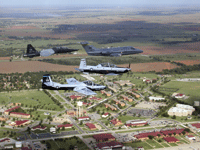A useful little feature of eBay online auctions has turned out to be exactly what the Pentagon ordered, at least when it comes to giving a heads-up to Air Force personnel in times of emergency.When an eager buyer is pursuing an item in an eBay auction, a pop-up will appear on the screen advising that time is running out on the bidding process.The Air Force Air Education and Training Command has adapted this application for use in its Installation Warning System (IWS), now being rolled out at all its bases.In December 2002, the Air Force issued an instruction on 'Full Spectrum Threat Planning and Operations.' Part of the instruction required each command to implement an alert system that could convey warnings and instructions to everyone on base.'We consider IWS a three-pronged attack, with the three components being Giant Voice, a Telephone Alerting System and the Networked Alerting System,' said Senior Master Sgt. Edwin Willson of the AETC Communications and Information Directorate's plans and policy division. 'What's important is that redundancy is built into the system to ensure the communication is given to those who need it, when it's needed.'Giant Voice is just what it sounds like'outdoor speakers on poles scattered throughout an installation, Willson said. It reaches personnel who are outside. The telephone alerting system will dial several preprogrammed numbers simultaneously to notify key individuals.It is the networked system that is likely to reach the most people, however, because a message will pop up on the hundreds or thousands of desktop computers being used on the unclassified networks throughout a base.All three elements are 'simultaneously activated, using the Giant Voice system, with the touch of one button and without any additional operator interface,' Willson said.The pop-up system is being provided by AtHoc Inc. of Burlingame, Calif.'The mandate at AETC is that every single installation should have it, and [the command] defined the standard,' said Guy Miasnik, president and CEO of AtHoc. 'Their goal was to create a comprehensive IWS that includes the classic sirens and public address systems and the telephony systems, but ... what truly made it compliant was the use of the networks.'The alert system software is installed in the network operating center. It has received all the security certificates required by the Air Force and has been cleared for use on both the Secret IP and Non-Classified IP router networks.'From a capability perspective, we provide the ability to send to predefined lists based on different scenarios,' Miasnik said. The pop-ups contain instructions regarding how to respond to specific alerts, from natural disasters to chemical spills to terrorist attacks. In addition, recipient lists can be tailored and messages can be customized on the fly to address situations outside the standard lists, he said.The command wanted to include a networked alerting system because it's a much more flexible medium than either sirens or telephones, Miasnik said.'While they are focusing on the emergency notification [aspects], it is expanding their communications capabilities,' he said, such as providing IT-oriented alerts if a virus is targeting their networks. In addition, it also builds in the ability to track the effectiveness of the system.'Part of the system is actually a tracking and reporting system. It tracks every notification and the user can click on an 'acknowledge' or 'get more information' button,' he said. 'By clicking either one, the acknowledgement is registered and can be used by the operator to know the effectiveness of the warning. It can also potentially be used to escalate an alert'if there's a specific alert to a group and no one answers, you can send another alert to the same group, or to a backup.'AETC has more than 100,000 personnel, including active-duty, Air National Guard, Air Force Reserve, civilian and contractor employees, spread over 13 bases around the country. So far, six of the installations have purchased AtHoc's networked component. Willson said the remaining seven plan to buy the software as funding be- comes available.When completed, the contract will be worth about $2 million, Miasnik said. The company also received a two-year support contract for the AETC system. Once all of the bases have deployed it, AtHoc will work with AETC to tie all the systems together at the command level.So far, the IWS has been implemented at two locations'Randolph Air Force Base, the headquarters for AETC, near San Antonio, and Vance Air Force Base, Okla., Miasnik said.It is about to be rolled out at Shepherd Air Force Base, also in Texas, and the company is devising an implementation schedule for the other three bases.Tosia Preine, a civilian employee at AETC, was the point of contact for the project at Randolph.Phase one of the NAS was installed in the middle of July, she said.'We got one server [set up], capable of handling about 5,000 users,' she said. Phase two, the remaining two servers, was completed at the end of October.'We've had three or four exercises with it,' Preine said. 'We used it for weather warnings, too. We've tweaked it; there are things we liked about it, things we changed. The good thing is, you don't have to check your e-mail to know what's going on. ... No matter what you're doing, this little pop-up activates and you know what's happening instantly.'As for implementing the system throughout all Air Force bases, Willson said his command does not endorse any particular company.'However, AETC does work hard to maintain a cross-flow of information with other commands to share innovative ideas and improved processes,' he said. 'AETC has shared with other commands our IWS concept and how we have defined the components of an IWS.'
SPREAD THE WORD: Vance AFB is one of two bases so far using the Installation Warning System.







